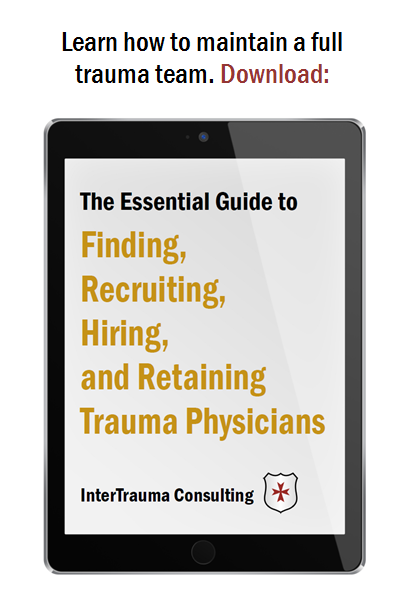Physician burnout is a growing problem in healthcare, especially for trauma surgeons and other emergency providers. While burnout can create serious physical and mental health challenges for trauma physicians, it also puts trauma programs at risk.
Clearly, physicians who are edging toward burnout are more likely to resign and seek other employment. The problem is that in many hospitals, losing even one trauma surgeon will leave the entire program short-staffed.
Insufficient staffing can easily put a hospital’s trauma center designation at risk. Several level II trauma centers have lost their verification because they were trying to run their program with just two or three trauma surgeons.
Exacerbating this problem is the growing shortage of qualified trauma surgeons. In the current environment, trauma program leaders need to do everything they can to keep their medical staff emotionally healthy and ready for work. The first step is to identify the root causes of burnout among trauma physicians:
1. Running a “too lean” medical staff
No sports team would start a game without a full complement of substitutes on the bench. You need to bring in fresh players or risk wearing out the squad. Yet in many trauma centers, the medical staff is just big enough to cover the existing case volume.
How do you know when your trauma medical staff is too lean? Any disruption to the normal call schedule—for training, personal illness, vacation, family emergency, etc.—creates a mini-crisis in trauma coverage. When that happens, the remaining trauma team must make heroic efforts to cover the schedule. In the worst situations, a trauma surgeon may be up for three nights in a row. When this happens too often, the inevitable result is burnout.
2. Burdening physicians with too many extra duties
The flip side of lean trauma staffing is an over-sized job description for trauma surgeons. In many programs, physicians’ non-trauma duties practically amount to a second part-time career.
Non-call clinical duties are one side of the problem. In many hospitals, trauma surgeons are expected to provide comprehensive post-op care on top of their normal case load and even see patients in the clinic for follow-up appointments. In other hospitals, outpatient cases originally seen as inpatients are managed by the on-call trauma attending. Trauma surgeons are frequently called in for interval cholecystectomies, appendectomies and wound care requiring operative management.
In addition, trauma surgeons are regularly on the receiving end of decrees from hospital administration to increase clinical services. I am familiar with one hospital where the chief operating officer abruptly decided that the trauma faculty should cross-cover the medical ICU. This decision had a huge impact on the trauma team workload, and the trauma surgeons themselves were never consulted.
Excessive added duties can deplete trauma surgeons, especially in programs with marginal staffing levels. Even worse, they can lead to a sense of powerlessness before program leadership and hospital administration. Both problems increase the risk of physician burnout.
3. Ignoring the small issues that erode morale
Every job brings with it a host of minor irritants, and trauma surgery is no different. But when these “small issues” begin to pile up, they can have a serious negative impact on a physician’s overall outlook.
For example, teaching ATLS while also trying to be on call or post-call can be draining. Even more exhausting is having to sit through countless meetings after being in the OR all night—or seeing a slew of trauma clinic follow-ups in the afternoon after a call.
Staff interactions are another common source of cumulative stress. For instance, in some facilities a nurse may page trauma surgeons directly (instead of going through a physician assistant or resident) for things that could clearly wait until morning. The physician’s role is to be available for these consultations, but responding to every question without a mid-level filter can be exhausting and slowly wear down a provider’s morale.
The key dimension is time. Minor issues that remain unresolved for months or years can eventually drain the energy from your medical staff.
A solvable problem
All of the mistakes described above have a solution. For example, you could instruct your answering service not to page the trauma attending for routine consults until the morning if they come in between 11 p.m. and 7 a.m. Saving them up until morning will allow the provider to get some rest if everything else is quiet, and it should have no impact on clinical care.
Overall, trauma program leaders need to monitor physician workloads, spin off duties to mid-level providers, rationalize call schedule policies, and work to remove the minor frictions that cumulatively lead to burnout. The cornerstone of all these efforts is adequate staffing. Trauma programs that maintain a full physician team can keep individual workloads manageable and free surgeons to focus on patient care and performance improvement.
To find out how to build and maintain a full trauma team, download The Essential Guide to Finding, Recruiting, Hiring and Retaining Trauma Physicians. This free ebook from InterTrauma Consulting will show you how to make the case for additional trauma staffing budget, find and evaluate strong candidates, develop an effective mix of recruiting incentives, and master the factors that are critical to long-term physician retention.
Alex Guerrero, MD, MSc, FACS is a board-certified surgeon specializing in trauma and burns with added experience in population-based injury epidemiology. In addition to his clinical responsibilities, he is the founder of Trauma Ready, a consulting firm that helps trauma centers increase revenue and improve quality. He is also the managing director of InterTrauma Consulting, a premium locum and permanent staffing firm for trauma centers.


